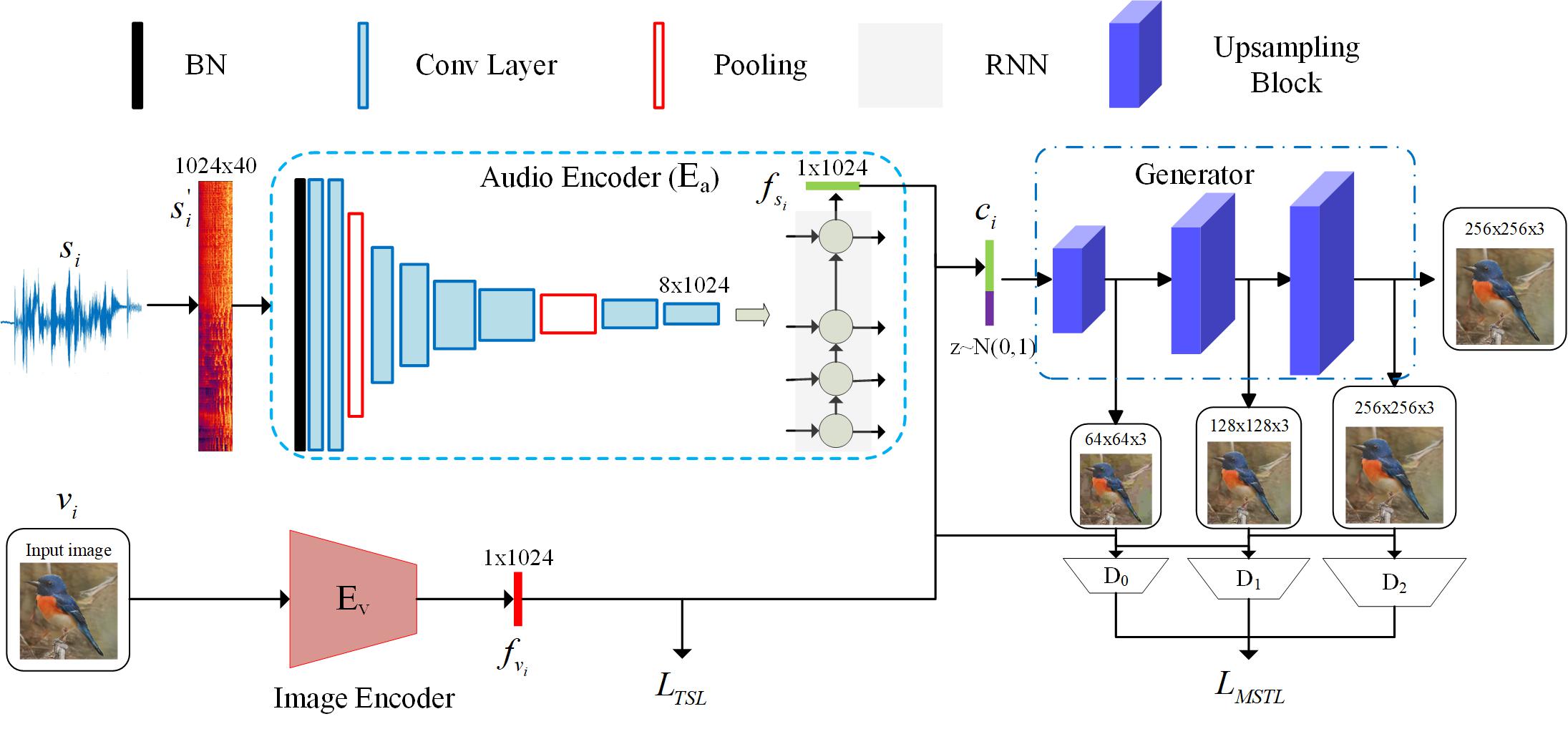 Our model aims to translate speech signals into image without the middle text representation. We use a speech encoder based CNN+RNN to extract an embedding feature from the input speech description and synthesize images with semantical consistancy by a stacked generator.
This project provides the code for training the model and the method to evaluate the model on synthesized and real data.
Our model aims to translate speech signals into image without the middle text representation. We use a speech encoder based CNN+RNN to extract an embedding feature from the input speech description and synthesize images with semantical consistancy by a stacked generator.
This project provides the code for training the model and the method to evaluate the model on synthesized and real data.
You can take a look about our resluts on our speech-to-image project home page.
If you use this code or part of it, please cite us!
Jiguo Li, Xinfeng Zhang, Chuanming Jia, Jizheng Xu, Li Zhang, Yue Wang, Siwei Ma, Wen Gao, "Speech-to-Image Translation without Text" arxiv
- linux
- python 3.5 (not test on other versions)
- caffe(to extract the image feature)
- pytorch 1.0+
- librosa
- json, tqdm, logging
Here we use CUB-200 as example and other datasets are similar to CUB-200.
- Download CUB-200 dataset and put it to "./data/birds"
- Download the train/split file from our speech-to-image project main page.
- Run
python ./Audio_to_Image/text_to_speech.py --dataset birds --output_dir ./data/birds/CUB_200_2011_audio --APP_ID APP_ID --API_KEY API_KEY --SECRET_KEY SECRET_KEY
you can get APP_ID, API_KEY, SECRET_KEY from Baidu AI platform(free).
- Or you can download the speech data from our speech-to-image project main page.
- Extract image feautures using caffe googlenet(see details in "./prepare_image_features.py") or download the image feature from our speech-to-image project home page(recommend), then put the features for training into "./data/birds/train" and that for testing into "./data/birds/test".
-> tree ./data/birds -L 2
./data/birds
├── CUB_200_2011
├── CUB_200_2011_audio
│ └── audio
├── test
│ └── image_features_googlenet_caffe.pickle
├── test.json
├── train
│ └── image_features_googlenet_caffe.pickle
└── train.json
In the project dictionary "speech-to-image-translation-without-text", run
export PYTHONPATH=$PYTHONPATH:$(pwd)
bash ./run_audio_encoder.sh 1 --output_dir ./output/Audio_to_Image/log/birds_speech_encoder --epoch 1000 --eval_every 10 --lr_scheduler_step_size 200 --lr_scheduler_gamma 0.5 --loss_diff 1 --loss_same 0.1 --l1_flag --jel_flag --lambda_l1 5 --distill_flag --lambda_distill 1000 --learning_rate 1e-3 --dataset birds --bidirectional --rnn_layers 1
The training for CUB-200 dataset will cost about 1 day on a 1080ti GPU.
Run
python ./Audio_to_Image/extract_audio_feature.py --model ./output/Audio_to_Image/log/birds_speech_encoder/latest.pth --audio_switch googlenet_caffe --dataset birds --bidirectional --rnn_layers 1
the features will be save in "./data/birds/train" and "./data/birds/test".
Run
python ./StackGAN_v2/main.py --cfg ./StackGAN_v2/cfg/birds_3stages.yml --output_dir birds_speech_encoder --audio_switch googlenet_caffe --data_dir ./data/birds --branch_num 3
The training will cost about 3 days on a 1080ti GPU for no more than 220K iterations.
Run
python ./StackGAN_v2/main.py --cfg ./StackGAN_v2/cfg/eval_birds.yml --eval_net_g ./output/StackGAN_v2/birds_speech_encoder/Model/netG_220000.pth --output_dir birds_speech_encoder --audio_switch googlenet_caffe --data_dir ./data/birds --branch_num 3
to generate images conditioned on the input speech descriptions on testing set. Than we use FID and IS to evaluate the result.
our results, data, pretrained model can be found on our speech-to-image project main page.
Thanks to the valuable discussion with Shiqi Wang. Besides, thanks to the open source of StackGAN v2, DaveNet, FID and IS, as well as the free use of Baidu TTS.